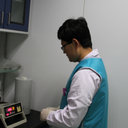Hematopoietic effects and mechanisms of Fufang e׳jiao jiang on radiotherapy and chemotherapy-induced myelosuppressed mice.
Keywords
Abstract
BACKGROUND
Fufang e׳jiao jiang (FEJ), which has been widely used in clinic to replenish qi (vital energy) and nourish blood, is a famous traditional Chinese medicine formula made up of Colla corii asini (donkey-hide gelatin prepared by stewing and concentrating from the hide of Equus asinus Linnaeus.), Radix codonopsis pilosulae (the root of Codonopsis pilosula (Franch.) Nannf.), Radix ginseng rubra (the steamed and dried root of Panax ginseng C.A. Mey.), Fructus crataegi (the fruit of Crataegus pinnatifida Bunge) and Radix rehmanniae preparata (the steamed and sun dried tuber of Rehmannia glutinosa (Gaertn.) Libosch. ex Fisch. & C.A. Mey.). The present study aimed to investigate the hematopoietic effects of FEJ on myelosuppressed mice induced by radiotherapy and chemotherapy systematically and to explore the underlying hematopoietic regulation mechanisms.
METHODS
The myelosuppressed mouse model was induced by (60)Co radiation, cyclophosphamide and chloramphenicol. FEJ was then administered by i.g. at the dosages of 5, 10, or 20 mL/kg·d for 10d. The numbers of blood cells from peripheral blood and bone marrow nucleated cells (BMNC) were counted. Body weight and the thymus and spleen indices were also measured. The numbers of hemopoietic progenitor cells and colony-forming unit-fibroblast (CFU-F) were measured in vitro. The ratio of hematopoietic stem cells (HSC) in BMNC, cell cycle and apoptosis of BMNC were determined by flow cytometry. The histology of femoral bone was examined by H&E staining. The levels of transforming growth factor-β (TGF-β), tumor necrosis factor-α (TNF-α), erythropoietin (EPO), granulocyte-macrophage colony-stimulating factor (GM-CSF), interleukin-3 (IL-3) and interleukin-6 (IL-6) in serum were measured by ELISA. IL-1β, IL-3, IL-6 mRNA levels in spleen were detected by real-time quantitative PCR (RT-qPCR). In addition, bone marrow stromal cells (BMSC) were cultured in vitro followed by treatment with different doses of FEJ (2.5, 5, 10 μL/mL) for 48 h. Then the levels of cytokines (IL-6, SCF, GM-CSF) in the conditioned media and their mRNA levels in BMSC were determined by ELISA and RT-qPCR, respectively.
RESULTS
FEJ could significantly increase the numbers of peripheral blood cells and BMNC, and reverse the loss of body weight and the atrophy of thymus and spleen in a dose-dependent manner. The quantities of hemopoietic progenitor cells and CFU-F in bone marrow were also significantly increased in a dose-dependent manner after FEJ administration. A high-dose FEJ of 20 mL/kg·d could significantly increase the ratio of HSC in BMNC, promote bone marrow cells entering the proliferative cycle phase (S+G2/M) and prevent cells from proceeding to the apoptotic phase. FEJ could also improve the femoral bone marrow morphology. Furthermore, FEJ could increase the levels of GM-CSF and IL-3 and reduce the level of TGF-β in serum, and enhance the expressions of IL-1β and IL-3 mRNA in spleen. Lastly, the levels of cytokines (IL-6, SCF, GM-CSF) in the conditioned media and their mRNA levels in BMSC were elevated after treatment with FEJ.
CONCLUSIONS
FEJ was clearly confirmed to promote the recovery of bone marrow hemopoietic function in a myelosuppressed mouse model, which may be attributed to (i) improving bone marrow hematopoietic microenvironment; (ii) facilitating the cell proliferation and preventing BMNC from apoptosis; (iii) stimulating the expressions of IL-1β, IL-3, IL-6, SCF and GM-CSF and inhibiting the expression of TGF-β.



